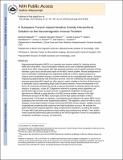A Subspace Pursuit-based Iterative Greedy Hierarchical solution to the neuromagnetic inverse problem
Author(s)
Babadi, Behtash; Obregon-Henao, Gabriel; Lamus, Camilo; Brown, Emery N.; Hamalainen, Matti S.; Purdon, Patrick Lee; ... Show more Show less
DownloadBrown_A subspace.pdf (4.688Mb)
PUBLISHER_CC
Publisher with Creative Commons License
Creative Commons Attribution
Terms of use
Metadata
Show full item recordAbstract
Magnetoencephalography (MEG) is an important non-invasive method for studying activity within the human brain. Source localization methods can be used to estimate spatiotemporal activity from MEG measurements with high temporal resolution, but the spatial resolution of these estimates is poor due to the ill-posed nature of the MEG inverse problem. Recent developments in source localization methodology have emphasized temporal as well as spatial constraints to improve source localization accuracy, but these methods can be computationally intense. Solutions emphasizing spatial sparsity hold tremendous promise, since the underlying neurophysiological processes generating MEG signals are often sparse in nature, whether in the form of focal sources, or distributed sources representing large-scale functional networks. Recent developments in the theory of compressed sensing (CS) provide a rigorous framework to estimate signals with sparse structure. In particular, a class of CS algorithms referred to as greedy pursuit algorithms can provide both high recovery accuracy and low computational complexity. Greedy pursuit algorithms are difficult to apply directly to the MEG inverse problem because of the high-dimensional structure of the MEG source space and the high spatial correlation in MEG measurements. In this paper, we develop a novel greedy pursuit algorithm for sparse MEG source localization that overcomes these fundamental problems. This algorithm, which we refer to as the Subspace Pursuit-based Iterative Greedy Hierarchical (SPIGH) inverse solution, exhibits very low computational complexity while achieving very high localization accuracy. We evaluate the performance of the proposed algorithm using comprehensive simulations, as well as the analysis of human MEG data during spontaneous brain activity and somatosensory stimuli. These studies reveal substantial performance gains provided by the SPIGH algorithm in terms of computational complexity, localization accuracy, and robustness.
Date issued
2013-09Department
Institute for Medical Engineering and Science; Harvard University--MIT Division of Health Sciences and Technology; Massachusetts Institute of Technology. Department of Brain and Cognitive Sciences; McGovern Institute for Brain Research at MITJournal
NeuroImage
Publisher
Elsevier
Citation
Babadi, Behtash, Gabriel Obregon-Henao, Camilo Lamus, Matti S. Hamalainen, Emery N. Brown, and Patrick L. Purdon. “A Subspace Pursuit-Based Iterative Greedy Hierarchical Solution to the Neuromagnetic Inverse Problem.” NeuroImage 87 (February 2014): 427–443.
Version: Author's final manuscript
ISSN
10538119
